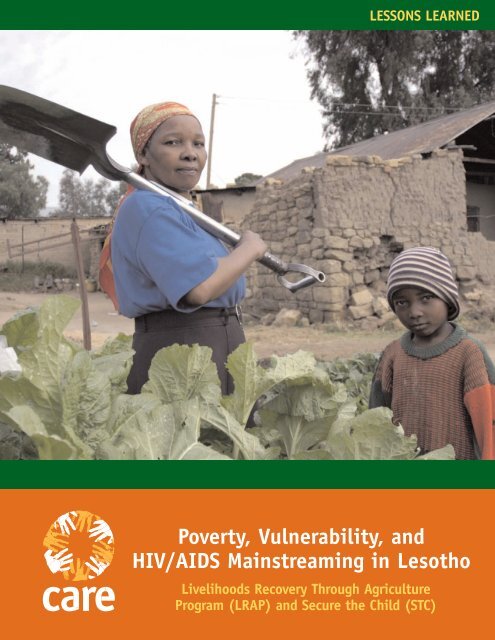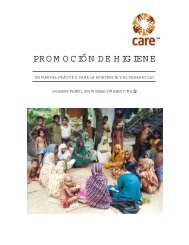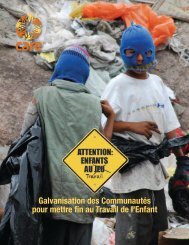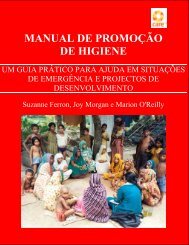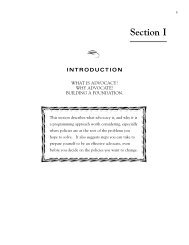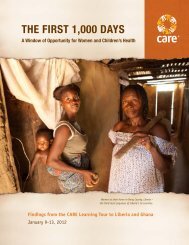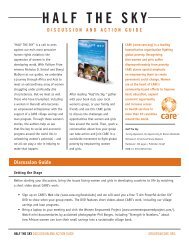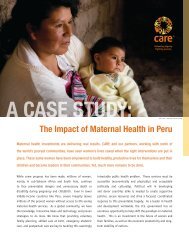Lesotho - CARE International UK
Lesotho - CARE International UK
Lesotho - CARE International UK
You also want an ePaper? Increase the reach of your titles
YUMPU automatically turns print PDFs into web optimized ePapers that Google loves.
LESSONS LEARNED<br />
Poverty, Vulnerability, and<br />
HIV/AIDS Mainstreaming in <strong>Lesotho</strong><br />
Livelihoods Recovery Through Agriculture<br />
Program (LRAP) and Secure the Child (STC)
| LRAP AND STC lessons learned<br />
1<br />
LESOTHO<br />
Summary<br />
Improving food production and nutrition is<br />
one of the best ways to help vulnerable households<br />
cope with HIV/AIDS and its impacts.<br />
There is a strong two-way relationship between<br />
food insecurity and the epidemic: households<br />
affected by HIV/AIDS have less time and energy<br />
for food production, while reduced access to<br />
food increases people’s general vulnerability and<br />
accelerates the disease in those already infected.<br />
Homestead gardening can help to break this<br />
connection. It offers a wider range of potential<br />
crops than field-based agriculture, requires less<br />
time and labor and can provide a source of extra<br />
income. Meanwhile, mainstreaming HIV/AIDS<br />
concerns into agricultural programs also helps to<br />
reduce the stigma associated with HIV and build<br />
partnerships with other organizations.<br />
Effective approaches to mainstreaming<br />
HIV/AIDS into improved food production<br />
and nutrition in <strong>Lesotho</strong> include:<br />
● Emphasizing positive living in all projects.<br />
● Casting a wider net in identifying the most<br />
vulnerable households for support, especially<br />
those headed by orphans, women or the very poor.<br />
● Researching good practices in food gardening<br />
for vulnerable households.<br />
● Supporting the Ministry of Agriculture and<br />
Food Security’s Unified Extension System.<br />
● Giving grants and technical support to civil<br />
society organizations and others working in<br />
homestead gardening.<br />
● Mainstreaming gender and HIV/AIDS into<br />
<strong>CARE</strong>’s agricultural programs and those of partners.<br />
● Developing partnerships and links among<br />
government, the private sector and civil society,<br />
and between those sectors and rural communities.<br />
Start and end dates: Oct. 2002 – Sept. 2005<br />
Main topic: HIV/AIDS<br />
Contacts: PJ Lerotholi – Rural livelihoods<br />
Theme Coordinator, plerotholi@care.org.ls<br />
Tel: 266 2231 4398 or 26658865811 or<br />
Luann Hatane – HIV/AIDS Theme<br />
Coordinator, lhatane@care.org.za<br />
Tel: 27 11 4033288 or 27 836523057<br />
Principle Donors: Department for <strong>International</strong><br />
Development (DFID), <strong>UK</strong>, Norwegian Ministry<br />
of Foreign Affairs<br />
Goal: To help vulnerable rural households cope<br />
with shocks and stresses, especially given the<br />
increasing impact of HIV/AIDS.<br />
Objectives:<br />
● Help vulnerable rural households improve their<br />
food production.<br />
● Mainstream HIV/AIDS into agricultural and<br />
food interventions.<br />
● Support partner organizations working in the<br />
areas of HIV/AIDS and food security.<br />
Background<br />
<strong>Lesotho</strong> gained independence from Britain<br />
four decades ago. The kingdom is surrounded by<br />
its massive neighbor, South Africa, and has a<br />
population of about 2.2 million people, of whom<br />
1.37 million live in rural areas.<br />
Despite <strong>Lesotho</strong>’s agrarian base, rural livelihoods<br />
in the 20th century became dependent upon<br />
men’s migration to South African mines. This<br />
combination of crop and livelihood production at<br />
home and wage earning at distant mines created a<br />
complex household livelihood cycle, but rarely<br />
lifted families out of poverty. In a study carried<br />
out between 1994 and 1995 1 , 58 percent of the<br />
population was found to be living below the<br />
poverty line, while 38 percent was below an “ultra<br />
poverty line.” In 2002, the United Nations ranked<br />
<strong>Lesotho</strong> 145 out of 177 countries in its human<br />
development index. 2<br />
Over the last decade, <strong>Lesotho</strong>’s society, economy<br />
and livelihoods have changed significantly.<br />
Farming has been adversely affected by several<br />
bouts of reduced rainfall which have exacerbated<br />
food shortages and accelerated migration to<br />
urban areas. There has been a rapid expansion<br />
in women’s employment in factory jobs in the<br />
country’s largely Chinese-controlled garment<br />
industry, making it Africa’s largest exporter of<br />
textiles to the United States. However, these jobs<br />
pay relatively little compared to what men once<br />
earned in the mines, and the garment sector<br />
as a whole is threatened by recent changes in<br />
international trade agreements. Meanwhile,
migrant labor opportunities in South Africa have<br />
been halved – rural households can no longer be<br />
based around men’s mining careers.<br />
Overarching these transformations have been<br />
the multiple impacts of the HIV/AIDS epidemic.<br />
Although data is incomplete, <strong>Lesotho</strong> is believed<br />
to have one of the highest infection rates in the<br />
world. At the end of 2003, an estimated 29<br />
percent of persons aged 15-49 were HIV positive,<br />
some 29,000 people had died from AIDS and at<br />
least 100,000 children had lost one or both<br />
parents to the disease. 3 Much social and economic<br />
progress has been undone as every sector of<br />
national life is affected by rapidly increasing labor<br />
shortages and the ever-heavier burden of caring<br />
for the sick.<br />
Program Overview<br />
Established in <strong>Lesotho</strong> in 1968 and South<br />
Africa in 1994, the joint <strong>CARE</strong> South Africa-<br />
<strong>Lesotho</strong> mission was created in 2001 to promote<br />
integrated regional programming and lessonlearning.<br />
The mission has head offices in<br />
Johannesburg, South Africa, and Maseru, <strong>Lesotho</strong>.<br />
In <strong>Lesotho</strong>, <strong>CARE</strong> is working across the<br />
country to tackle poverty and its causes. While<br />
the focus of this work was initially agrarian,<br />
<strong>CARE</strong> is now digging deeper into the roots<br />
of poverty, adding new dimensions to the<br />
organization’s interventions.<br />
Training for Environmental and Agricultural<br />
Management (TEAM)<br />
In 1995, <strong>CARE</strong> South Africa-<strong>Lesotho</strong> launched<br />
the TEAM project with the Ministry of Agriculture<br />
and Food Security (MoAFS), 4 supported by<br />
Norwegian funding. The project focused on<br />
demonstrating effective methods for improving<br />
rural livelihoods in Mohales Hoek and Quthing<br />
districts. It was based upon a farmer-to-farmer<br />
extension method that aimed to improve the<br />
knowledge and practices of rural agricultural<br />
workers, including their decision-making and<br />
problem-solving abilities.<br />
At first, TEAM took a fairly conventional<br />
technical approach to improved agriculture and<br />
natural resource (ANR) strategies for rural house-<br />
LESSONS LEARNED
| LRAP AND STC lessons learned<br />
3<br />
LESOTHO<br />
holds, supported by the ministry’s emerging<br />
Unified Extension Service. Its main innovation<br />
was piloting methods of participatory extension,<br />
planning and learning. During a British-funded<br />
phase (1997 to 2002), the project was guided in<br />
its design and operation by the household livelihood<br />
security framework, a growing understanding<br />
of the importance of gender- and rights-based programming,<br />
and a commitment to making extension<br />
and agricultural innovation more effective through<br />
participatory planning and learning.<br />
Neither TEAM nor <strong>CARE</strong>’s other rural project,<br />
promoting social forestry in the highlands,<br />
addressed HIV/AIDS directly. However, the<br />
organization was becoming all too aware of the<br />
escalating crisis. Efforts were made to include<br />
messages relating to the epidemic in TEAM’s extension<br />
content, while staff included the subject in<br />
their discussions with rural people about ANR<br />
techniques. While arguably raising some awareness<br />
about HIV/AIDS and safe sex, this approach often<br />
bemused farmers who thought they had come to<br />
discuss farming and conservation practices. In<br />
addition, staff felt uncomfortable dealing with an<br />
issue for which they were not trained.<br />
Overall, this well-meaning but essentially<br />
“add-on” approach had little effect: the<br />
messages focused on awareness of HIV/AIDS and<br />
• NATURAL RESOURCES<br />
• INSTITUTIONS<br />
• INFRASTRUCTURE<br />
• ECONOMIC, CULTURAL<br />
AND POLITICAL<br />
ENVIRONMENT<br />
• DEMOGRAPHY<br />
SHOCKS<br />
& STRESSES<br />
<strong>CARE</strong>’S LIVELHOOD SECURITY MODEL<br />
Natural Capital<br />
(resources)<br />
Production<br />
&<br />
Income<br />
Activities<br />
Human Capital<br />
(livelhood<br />
capabilities)<br />
ASSETS<br />
HOUSEHOLD<br />
Processing,<br />
Exchange,<br />
Marketing<br />
Activites<br />
safe sex, but did not connect the issue with<br />
livelihood strategies. Nor did the messages<br />
relate TEAM’s own core theme – sustainable food<br />
production – to increased resilience to the<br />
epidemic and its impact. Indeed, a document<br />
reviewing the last phase of TEAM noted that<br />
promoting women’s empowerment could help<br />
women take more control over their sexual<br />
health, social empowerment by TEAM could<br />
facilitate contacts with health and other service<br />
providers, and the organization’s HIV/AIDS<br />
projects could help raise awareness among<br />
TEAM’s staff. 5 It was time for <strong>CARE</strong> South Africa-<br />
<strong>Lesotho</strong> to rethink its approach.<br />
The challenge: HIV/AIDS mainstreaming<br />
By 2000 the long-standing livelihood links<br />
between the country’s rural areas and South<br />
Africa’s urban and mining sectors were well<br />
known. The rapidly growing domestic links<br />
between rural livelihoods and urban areas were<br />
also apparent. North and south from Maseru,<br />
across the lowlands and foothills of the country,<br />
the rural and urban sectors were increasingly<br />
merging into a low-density mix of livelihoods<br />
and land uses. With the lines increasingly<br />
blurred, it was obvious that HIV/AIDS was as<br />
much a rural crisis as an urban one.<br />
Social Change<br />
(Claims &<br />
Access)<br />
CONTEXT LIVELHOOD<br />
STRATEGY<br />
Financial Capital<br />
(resources)<br />
Consumption<br />
Activites<br />
SECURITY OF:<br />
• FOOD<br />
• NUTRITION<br />
• HEALTH<br />
• WATER<br />
• SHELTER<br />
• COMMUNITY<br />
PARTICIPATION<br />
• PERSONAL SAFETY<br />
LIVELHOOD<br />
INCOME
<strong>CARE</strong> documented these dynamics when reviewing<br />
trends in <strong>Lesotho</strong>’s livelihoods over two<br />
decades. 6 While the organization’s first HIV/AIDS<br />
interventions had focused on urban youth, it was<br />
clear that people across the country needed help<br />
to curb infections and deal with the impact of the<br />
disease. While much of <strong>CARE</strong>’s work with MoAFS<br />
had a rural livelihoods perspective, it became clear<br />
<strong>CARE</strong> needed an integrated approach to the<br />
country’s new semi-rural, semi-urban sectors.<br />
<strong>CARE</strong>’s merged South Africa-<strong>Lesotho</strong> program<br />
focuses on four common themes: rural livelihoods,<br />
HIV/AIDS, economic empowerment, and inclusive<br />
and democratic governance. Through a series of<br />
workshops and programming reflections, <strong>CARE</strong><br />
came to understand that mainstreaming these<br />
issues meant integrating them into everyday<br />
business. <strong>CARE</strong> also endorsed Oxfam’s view that<br />
“mainstreaming is not a series of fixed activities,<br />
rather it is a process of changing attitudes and<br />
deepening understanding about complex issues …<br />
this requires continual learning and reflection.” 7<br />
Against this background, mainstreaming – of<br />
HIV/AIDS, gender and livelihoods – brought<br />
certain issues, perspectives and conceptual<br />
frameworks to the core of the organization’s<br />
commitment and behavior.<br />
At the generic level, the staff of <strong>CARE</strong> South<br />
Africa-<strong>Lesotho</strong> examined the notion of mainstreaming<br />
and its implications before<br />
exploring what it meant for each of the<br />
agency’s programming themes. At the technical<br />
level, <strong>CARE</strong> worked to ensure that the three<br />
subjects of mainstreaming were fully incorporated<br />
into program designs rather than being token<br />
“add-ons.”<br />
LESSONS LEARNED<br />
lessons learned LRAP AND STC | 4
| LRAP AND STC lessons learned<br />
5<br />
LESOTHO<br />
Bottling and pickling helps provide vegetables for the cold, winter months<br />
Strategies and Activities<br />
Livelihoods Recovery through Agriculture<br />
Program (LRAP)<br />
LRAP is a leading example of <strong>CARE</strong>’s mainstreaming<br />
work.<br />
In 2002, following a dramatic drop in food production<br />
caused by erratic rainfall, early frosts and<br />
hailstorms, <strong>Lesotho</strong>’s prime minister declared a<br />
state of emergency. With support from DfID, <strong>CARE</strong><br />
South Africa-<strong>Lesotho</strong> and MoAFS designed and<br />
began implementation of a program to provide a<br />
rapid response to the country’s food security crisis.<br />
LRAP was based upon lessons learned from<br />
TEAM, its predecessor. It began as a two-year<br />
program in four southern districts and used existing<br />
civil organizations working in the affected<br />
communities. It aimed to improve the livelihood<br />
security of vulnerable rural households by<br />
improving home gardening, increasing awareness<br />
of HIV/AIDS and influencing policy through<br />
practical intervention. The program was extended<br />
for a year, covering a total of six districts.<br />
A first step in mainstreaming HIV/AIDS into<br />
LRAP involved thinking about whom the project<br />
would benefit. While TEAM had targeted farmer<br />
groups, the new program focused on households<br />
affected by HIV/AIDS whose nutritional status was<br />
declining. Cognizant of the sensitivity and stigma<br />
associated with the epidemic, LRAP did not<br />
directly identify households living with the virus,<br />
but focused on households that were likely to have<br />
been affected by HIV/AIDS: those headed by<br />
women or children, caring for an orphan or having
a chronically sick member. At least 75 percent of<br />
participating households were targeted to fall into<br />
one of these categories, while at least 75 percent<br />
were also intended to fall into the category of poor<br />
or very poor, as defined by the community.<br />
The key to LRAP’s strategy was homestead food<br />
production. <strong>CARE</strong> South Africa-<strong>Lesotho</strong><br />
mainstreamed HIV/AIDS by examining how<br />
interventions in each sector could help prevent<br />
infections, ensure care and support for those<br />
already infected and/or lessen the impact of<br />
the epidemic on individuals, households and<br />
communities.<br />
<strong>CARE</strong>’s rationale for selecting homestead<br />
gardening as a key intervention was four-fold:<br />
1. Almost every household in <strong>Lesotho</strong> has<br />
access to land on its residential plot, while many<br />
lack fields. In villages, towns and peri-urban<br />
areas, housing densities are relatively low,<br />
leaving space for garden production. Water for<br />
extra irrigation is also more readily available in<br />
residential areas than fields.<br />
2. Lack of labor - a key element in food<br />
insecurity - is further exacerbated as HIV/AIDS<br />
takes its toll by weakening individuals, requiring<br />
more care by other household members.<br />
Relatively small and close to the house,<br />
Homestead food production<br />
homestead gardens require less time and effort<br />
from labor-scarce households and facilitate the<br />
compatibility of gardening and home nursing.<br />
The goal of LRAP is to increase efficiency of the<br />
land, helping families harvest more produce<br />
from the same area of land.<br />
3. Homestead gardening offers a range of<br />
vegetable crops, rather than the single staple<br />
grain usually grown in fields. This variety<br />
can improve household nutrition, which is<br />
especially important for individuals living with<br />
HIV/AIDS.<br />
4. Extra homestead garden produce can be<br />
sold, allowing vulnerable households to earn<br />
some cash.<br />
LRAP used a number of instruments to help<br />
increase the quantity and nutritional content of<br />
household garden produce. Using the experiential<br />
learning techniques developed by TEAM, LRAP<br />
produced a series of 11 learning modules on<br />
homestead gardening in a colorful manual to share<br />
with participating households. These pamphlets<br />
are written in both English and Sesotho.<br />
One priority issue for <strong>CARE</strong> South Africa-<strong>Lesotho</strong><br />
is access to water. While homestead gardens are<br />
usually better situated for irrigation than fields,<br />
there is still a need for better water management<br />
LESSONS LEARNED<br />
When they have them, a family’s fields are generally entirely arable land: often degraded and eroding, often<br />
more than a kilometer away from the home. They tend to be large, on the scale of one or more hectares, as well<br />
as treeless and poorly terraced. Most years, they are used for the production of cereals and a few beans and peas.<br />
By contrast, a homestead garden is the land occupied and generally owned by a family, adjacent to the home<br />
and in the family’s complete control. Usually well under a quarter of a hectare, with as little as 25m 2 of arable<br />
soil, it is used for growing a few vegetables, with a few fruit trees or perhaps even a small pond catching<br />
run-off water for short-term irrigation.<br />
For families with a chronically-ill person to nurse, such as someone with HIV/AIDS-related illness, the option to<br />
grow food through a homestead garden in such close proximity may lead the family to abandon their fields in<br />
favor of a homestead garden.<br />
Source: Adapted from an LRAP Program Memorandum 2002.<br />
lessons learned LRAP AND STC | 6
| LRAP AND STC lessons learned<br />
7<br />
LESOTHO<br />
options. Those living with HIV/AIDS need<br />
increased and reliable water supplies if they are to<br />
cope adequately with their condition. Water<br />
harvesting is therefore a prominent part of LRAP’s<br />
technical guidelines, building on a series of pilot<br />
programs, including drip irrigation kits, roof water<br />
collection tanks and small dams.<br />
In mainstreaming HIV/AIDS concerns into<br />
its programming, <strong>CARE</strong> has given nutrition a<br />
prominent role. Emphasizing the increased<br />
nutritional needs of people living with HIV/AIDS,<br />
LRAP has developed a series of nutrition guidelines<br />
for <strong>Lesotho</strong>, which are promoted with MoAFS and<br />
civil society organizations. These include discussion<br />
questions, role plays, and demonstration<br />
activities and card games: they are intended for<br />
use by community-based health workers, homebased<br />
care providers, agricultural extension staff<br />
and school teachers.<br />
Partnership is another key aspect of <strong>CARE</strong>’s<br />
mainstreaming work. As a small, three-year<br />
program with just a few technical staff, <strong>CARE</strong> knew<br />
that LRAP could not achieve its aims through<br />
direct intervention. Instead, <strong>CARE</strong> aimed to mainstream<br />
HIV/AIDS awareness, commitment and<br />
action into the policies and practices of the<br />
<strong>Lesotho</strong> government (particularly the United<br />
Extension System of the MoAFS) and civil<br />
society (particularly local non-governmental<br />
organizations).<br />
Secure the Child (STC)<br />
Another initiative of <strong>CARE</strong> South Africa-<br />
<strong>Lesotho</strong> was STC, a sister program that grew out<br />
of LRAP and operated between June 2004 and<br />
July 2005.<br />
STC was a pilot project that operated in two<br />
districts - Mohales Hoek and Mokhotlong - and<br />
was funded by the Norwegian Ministry of Foreign<br />
Affairs. Its aim was to promote food safety nets<br />
for orphans and vulnerable children, and uphold<br />
their basic right to food by developing school<br />
gardens.<br />
The program targeted vulnerable children in<br />
selected schools that were the worst-affected by<br />
food insecurity and crisis. It operated through a<br />
sub-grants arrangement with two of LRAP’s local<br />
agricultural NGO partners – Rural Self Help<br />
Development Association (RSDA) and GROW –<br />
that worked with 12 mixed primary and high<br />
schools in Mohales Hoek district and nine<br />
primary schools in Mokhotlong district,<br />
respectively. The program sought to address the<br />
impact of HIV/AIDS by promoting vegetable<br />
production for consumption by orphans and<br />
vulnerable children both in and out of school.<br />
“LRAP has to be creative in opening<br />
pathways for new ideas that allow for<br />
mainstreaming and must accept that it<br />
may well be that small pilots of mainstreaming<br />
activities will be achievable,<br />
but major institutional changes may not<br />
[during the life of the project]. If these<br />
pilots create learning opportunities that<br />
are fully exploited they can still create the<br />
spark for major, long-term change.”<br />
<strong>CARE</strong> South Africa - <strong>Lesotho</strong>, 2003<br />
Like LRAP, STC emphasized partnerships: it was<br />
a joint initiative with the Ministry of Education<br />
and Training. Through this collaboration, STC<br />
aimed to influence the national school<br />
curriculum to incorporate agriculture as one of<br />
its key subjects, especially in primary schools.<br />
Program Outcomes, Results,<br />
and Sustainability<br />
Spread over six of <strong>Lesotho</strong>’s 10 districts, LRAP<br />
operated on a small-scale but witnessed many<br />
successes, including the following (through<br />
November 2004):<br />
● 1,368 households were reached in one district<br />
through the inclusion of a seed distribution<br />
program to support orphans.<br />
● 67 percent of participating households were<br />
either poor or very poor, as classified by their<br />
communities.
● 63 percent of participating households were in<br />
one of the target vulnerability groups (female or<br />
child headed and/or caring for an orphan or chronically<br />
sick member).<br />
● 65 percent of participating households grew at<br />
least five types of vegetable crop in their gardens.<br />
However, only 33 percent produced food in all four<br />
nutritional categories (vitamins, minerals, carbohydrates<br />
and proteins) – which shows room for<br />
improvement.<br />
● 48 percent of participating households got produce<br />
from their gardens all year round, despite<br />
<strong>Lesotho</strong>’s harsh winters. A further 25 percent got<br />
produce most of the year.<br />
● 53 percent of participating households stabilized<br />
or increased their production.<br />
Meanwhile, the one-year pilot phase of STC also<br />
noted a number of achievements:<br />
● Development of 21 school gardens, covering<br />
more than 13,000m2 .<br />
● Assistance to more than 3,800 pupils to<br />
improve their nutrition.<br />
● Training children to develop gardening skills<br />
that they could use at home.<br />
● Training young people at each site to share<br />
gardening skills and provide peer support for<br />
gardening production in their communities.<br />
Lessons Learned<br />
HIV/AIDS mainstreaming requires addressing the<br />
epidemic in a holistic manner. From the starting<br />
point of improved nutrition, the notion of ‘positive<br />
living’ has become a guiding principle in all of<br />
<strong>CARE</strong>’s work in <strong>Lesotho</strong>. Though primarily a set of<br />
attitudes and principles to help people living with<br />
HIV/AIDS, ‘positive living’ is a valuable approach<br />
for all people, strengthening the morale, dignity,<br />
purpose and social commitment of all who<br />
endorse and adopt it.<br />
LESSONS LEARNED
| LRAP AND STC lessons learned<br />
9<br />
LESOTHO<br />
Watering cabbages in a home garden<br />
● Partnerships are essential to achieving and<br />
scaling-up successful HIV/AIDS mainstreaming.<br />
Getting different agencies to adopt common goals<br />
and approaches is a difficult but necessary strategy<br />
if program successes are to be expanded to a<br />
larger scale. LRAP’s work with MoAFS and civil<br />
society organizations ensured greater funding, a<br />
pool of skilled personnel to meet the program’s<br />
objectives and a ready network of community<br />
contacts to do the ground work in mobilizing<br />
communities.<br />
● Household gardening can improve livelihoods,<br />
which is particularly important for families affected<br />
by HIV/AIDS. Households coping with the<br />
impact of the epidemic have greater nutritional<br />
needs, while enhanced nutrition helps mitigate<br />
the impact of the disease. Most homes have some<br />
adjacent land which can be used to grow food, and<br />
household gardening requires less time and effort<br />
than cultivating crops in a distant field.<br />
Individual gardens allow a wider variety of foodstuffs<br />
to be produced, thus improving household
nutrition. Overall, <strong>CARE</strong>’s experiences in LRAP<br />
showed that people are willing to embrace new<br />
gardening techniques if the benefits are made<br />
clear to them. They are also able to overcome<br />
problems – such as shortages of water, seeds<br />
or fertilizer – by being innovative and using<br />
inexpensive local resources.<br />
● While supporting a community’s most<br />
vulnerable households is vital, it does not require<br />
the specific targeting of those affected by<br />
HIV/AIDS. In order to be sensitive to the stigma<br />
associated with the epidemic in <strong>Lesotho</strong>, LRAP<br />
does not directly identify households living with<br />
HIV/AIDS. Instead, the program’s extension<br />
messages and field activities are open to all<br />
households, with a focus on those headed by<br />
women or children, or those caring for an orphan<br />
or chronically sick family member.<br />
● Programs must remain active in national<br />
HIV/AIDS policy processes. Given the pervasive<br />
character of the epidemic, it is important to<br />
advocate for mainstreamed thinking and a holistic<br />
approach to HIV/AIDS at all levels of<br />
government. This strategy has meant reaching out<br />
to a wider range of sectors than those with which<br />
<strong>CARE</strong> has traditionally worked in <strong>Lesotho</strong>, such as<br />
the Ministry of Education and Training in the case<br />
of STC. Overall, it is important to remain engaged<br />
with the country’s Poverty Reduction Strategy,<br />
seeking to mainstream HIV/AIDS<br />
concerns and employing a holistic approach to the<br />
problem. At a technical level, <strong>CARE</strong> must remain<br />
involved with the National AIDS Council, which<br />
coordinates HIV/AIDS activities in <strong>Lesotho</strong>, to<br />
promote a ‘positive living’ approach.<br />
● Food security promotes peace. LRAP has<br />
taught <strong>CARE</strong> that improving food production<br />
helps to reduce conflicts within households and<br />
communities. Since the program began in 2002<br />
in Mafeteng district, for instance, there have<br />
been significantly fewer conflicts over<br />
rangelands and chieftainship boundaries, as<br />
communities report that they are fully occupied<br />
with tending to their household assets.<br />
Conclusion<br />
<strong>CARE</strong> South Africa-<strong>Lesotho</strong> has had some success<br />
in mainstreaming HIV/AIDS into its operations,<br />
particularly within homestead and school garden<br />
nutritional programs. Through emphasis on gardening<br />
and ‘positive living’, <strong>CARE</strong> has restructured<br />
its agricultural and rural livelihoods interventions<br />
to help reduce people’s risk of HIV infection and<br />
strengthen their resilience in the face of the<br />
epidemic’s impacts.<br />
At this juncture, <strong>CARE</strong> must build on these<br />
achievements and work towards a broader framework.<br />
<strong>Lesotho</strong>’s livelihoods are rapidly evolving<br />
and the old ‘rural vs. urban’ classifications no<br />
longer apply in many areas. As such, HIV/AIDS<br />
efforts need to be mainstreamed not only across<br />
the whole range of livelihoods programs, but also<br />
across the whole country.<br />
Author: Joanne Abbot, Mosele Lenka, PJ<br />
Lerotholi, Makojang Mahao and Sechaba<br />
Mokhamaleli.<br />
Acknowledgements: <strong>CARE</strong> South Africa -<br />
<strong>Lesotho</strong>, Ministry of Agriculture and Food<br />
Security, <strong>Lesotho</strong>, Local NGOs participating in<br />
LRAP and STC especially GROW, LCN, RSDA and<br />
Teba Development, <strong>CARE</strong> USA HIV/AIDS Unit<br />
and Marketing & Communications Unit.<br />
1 May J, Roberts B, Moqasa G and Woolard I, n.d. ‘Chapter 3: Poverty<br />
and Inequality in <strong>Lesotho</strong>,’ Durban: University of Natal: Submission for<br />
United Nations Development Program’s National Human Development<br />
Report.<br />
2 www.undp.org/statistics, 7 July 2005.<br />
3 United Nations Program on AIDS/World Health Organization (2004)<br />
‘Epidemiological Fact sheets on HIV/AIDS and Sexually Transmitted Inf<br />
ections: 2004 Update: <strong>Lesotho</strong>.’ Geneva: UNAIDS/WHO Working Group<br />
on Global HIV/AIDS and STI Surveillance.<br />
http://www.unaids.org/html/pub/publications/factsheets01/lesotho_e<br />
n_pdf.pdf<br />
4 Known at the time as the Ministry of Agriculture, Cooperatives and<br />
Land Reclamation (MoACLR).<br />
5 <strong>CARE</strong> South Africa - <strong>Lesotho</strong>, 2000:17.<br />
6 Turner S.D, ‘The Southern African Food Crisis: <strong>Lesotho</strong> Literature<br />
Review.’ Maseru: <strong>CARE</strong> South Africa - <strong>Lesotho</strong>.<br />
7 <strong>CARE</strong> South Africa - <strong>Lesotho</strong>, op cit.<br />
Copyright ©2005 by Cooperative for Assistance and Relief Everywhere, Inc.<br />
(<strong>CARE</strong>). All rights reserved. <strong>CARE</strong>® and <strong>CARE</strong> Package® are registered marks of<br />
<strong>CARE</strong>. Photos ©2005 <strong>CARE</strong>/Brian Atkinson. Printed with soy-based inks,<br />
process chlorine-free.<br />
LESSONS LEARNED<br />
lessons learned LRAP AND STC | 10
www.care.org<br />
<strong>CARE</strong> <strong>International</strong> Secretariat<br />
Chemin de Balexert 7-9<br />
1219 Chatelaine<br />
Geneva<br />
Switzerland<br />
Tel: +41 22 795 1020<br />
Fax: +41 22 795 1029<br />
Email: info@care-international.org<br />
<strong>CARE</strong> Australia<br />
G.P.O. Box 2014<br />
Canberra, ACT 2601<br />
Australia<br />
Tel: 61-26-279-0200<br />
Fax: 61-26-257-1938<br />
E-mail: info@careaustralia.org.au<br />
<strong>CARE</strong> Canada<br />
9 Gurdwara Road<br />
Ottawa, ON K2E 7X6<br />
Canada<br />
Tel: 1-613-228-5600<br />
Fax: 1-613-226-5777<br />
E-mail: questions@care.ca<br />
<strong>CARE</strong> Danmark (Denmark)<br />
Noerrebrogade 68B<br />
Postbrooks 698<br />
DK-2200 Copenhagen N<br />
Danmark<br />
Tel: 45-35-36-88-58<br />
Fax: 45-35-36-88-78<br />
E-mail: care@care.dk<br />
<strong>CARE</strong> Deutschland (Germany)<br />
Dreizehnmorgenweg 6<br />
D-53175 Bonn<br />
Deutschland<br />
Tel: 49-228-975-630<br />
Fax: 49-228-975-6351<br />
E-mail: info@care.de<br />
<strong>CARE</strong> France<br />
CAP 19<br />
13 rue Georges Auric<br />
75019 Paris<br />
France<br />
Tel: 33-1-53-19-89-89<br />
Fax: 33-1-53-19-89-90<br />
E-mail: info-care@carefrance.org<br />
LESSONS LEARNED<br />
<strong>CARE</strong> Japan<br />
2-3-2 Zoushigaya<br />
Toshima-Ku<br />
Tokyo 171-0032<br />
Japan<br />
Tel: 81-3-5950-1335<br />
Fax: 81-3-5950-1375<br />
E-mail: carejpn@ny.airnet.ne.jp<br />
<strong>CARE</strong> Nederland (Netherlands)<br />
Juffrouw Idastraat 11<br />
2513 BE Den Haag<br />
The Netherlands<br />
Tel: 31 70 310 50 64<br />
Fax: 31 70 356 07 53<br />
E-mail: general@carenederland.org<br />
<strong>CARE</strong> Norge (Norway)<br />
Universitetsgt 12<br />
0164 Oslo<br />
Norway<br />
Tel: +47 22 99 26 00<br />
Fax: +47 22 99 26 01<br />
E-mail: care.norge@care.no<br />
<strong>CARE</strong> Österreich (Austria)<br />
Lange Gasse 30<br />
1080 Wien<br />
Österreich<br />
Tel: 43 1 715 0 715-0<br />
Fax: 43 1 715 9 715-12<br />
E-mail: care@care.at<br />
Raks Thai Foundation<br />
185-187 Phaholyothin Soi 11<br />
Samsen Nai, Phayathai<br />
Bangkok 10400<br />
Tel: 662-279-5306/7<br />
Fax: 662-271-4467<br />
Email: info@raksthai.org<br />
<strong>CARE</strong> <strong>UK</strong><br />
10-13 Rushworth Street<br />
London, SE 1 0RB<br />
United Kingdom<br />
Tel: 020-7934-9334<br />
Fax: 020 7934 9335<br />
E-mail: info@uk.care.org<br />
<strong>CARE</strong> USA<br />
151 Ellis Street, NE<br />
Atlanta, GA 30303-2440<br />
USA<br />
Tel: 1-404-681-2552<br />
1-800-521-<strong>CARE</strong><br />
Fax: 1-404-577-5977<br />
E-mail: info@care.org


